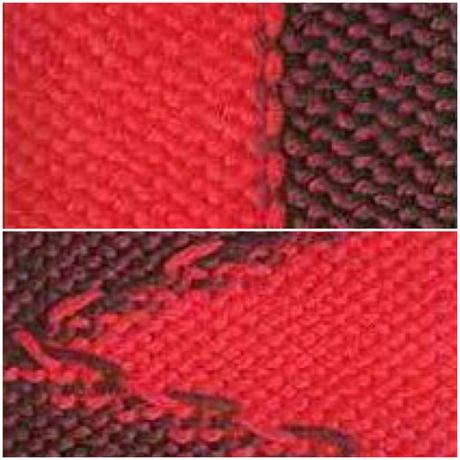Knitted things in the technique of intarsia turn out very beautiful and interesting. This type of knitting allows the use of different complex patterns, change the thread color is not only horizontally and vertically but also diagonally.
how knitting technique Intarsia? Consider the most common questions, and become familiar with different ways of knitting.

Intarsia technique / open sources
How to work on the scheme
Cells in the scheme corresponds to one loop width. Face a number of schemes is read from right to left. You need to knit a number of loops thread the same color as there are cells in width. In the purl row, the circuit is read from left to right.

Driving / open sources
How to start a new ball of
During the beginning of the work with the new ball, then, at this point, can form a space that will make the first loop of the new colors is very fragile. Over time, the product at this point to be dismissed. To prevent this, you need both threads (one for intarsia - the other for the background), to enter to work in the right place, but a number of earlier.
How many balls of yarn required for the performance of the product
When a new color section, starting from the right or left edge, then it is used by the new ball. If the new color section begins in the middle of the product, then you should use two additional coil: the first - to a new color, the second - to continue with the old color.

Balls of yarn / istockphoto.com
How to cross thread
1. When you change the color of both strands of the cross on the wrong side of the work to ensure that the hole is not formed. The personal number of the first loop provyazyvayutsya colored thread, placing it on top of the second strand, and then the product fit for the second thread.
2. The personal number for each thread systems cross, the old string is superimposed on a new one. In the same row purl, this is reversed: Each thread systems cross - a new thread is superimposed on the old one.
3. In the purl row provyazyvayut well as those of the first colored thread loop. 4. After second strand is superimposed over the first and further second article is knitted thread.
5. If there is a crossing of the vertical (or right or left by one loop), the short uniform filament sections are formed on the bottom side. If there is a crossing of the inclined (i.e. - several loops left or right in each row), then, the filaments are on the underside of the work before the next color portion.
6. When an assembly of filaments, it is necessary to make all of their ends on the wrong side in the places of their crossing.

How to cross the thread / open sources
How to Knit a symmetrical pattern
Sometimes requires pattern symmetry. For example, when you need to on the back and on the front part of the product was the same pattern. To do this, the knitting begins on the scheme: the work begins with a series of personal, but read the 1st row scheme - from left to right, and 2nd row (wrong) - right to left. This simple rule will help to achieve symmetry.
Change of color in the horizontal and vertical lines
During a change of colors, yarns are twisted to prevent the formation of holes in the knitted fabric. When the change of color in a vertical line, the yarn must be twisted in a row. Changing colors in a diagonal line, the thread must be twisted in every second row. If diagonal tilted to the right, twisted strands only facial series. If diagonal tilted to the left, twisted strands only backstitches ranks.

Changing colors / open sources
Color change in the vertical line
1. Front row. Remains of the old thread color at work. Rises a new color thread from under the old thread color, and fit until the next color change.
2. The back row. Remains of the old thread color to the work. Rises a new color thread from under the old thread color and fit until the next color change. So repeat steps 1 and 2.

Color change in the vertical line / open sources
Color change in the diagonal line
1. Performing a diagonal to the right, on the front side of the thread introduced a new color on the thread of the old color and fit until the next color change.
2. On the underside of the thread introduced new color from the color of the old yarn and knitted before the next color change.

Color change in the diagonal line to the right / open sources
1. By performing the diagonal left, on the underside of the new thread is introduced over the filament color old color and fit to the next color change.
2. On the front side of the new yarn is introduced from the color yarn is knitted and old color to the next color change.

Changing colors in a diagonal line to the left / open sources
Enter the new color
1. First captured the old thread, then a new thread, as in personal knitting and provyazyvaetsya first loop of both strands.
2. It remains an old thread. Provyazyvaetsya following two loops at both ends of the new thread.
3. It remains the short end of a new color and continue knitting with one thread. The following ranks provyazyvaetsya three double loops as a single.

Entering a new color / open sources
also read ABC needlewoman: how to knit spokes pattern enterlak

